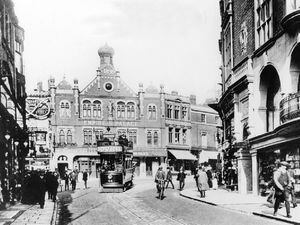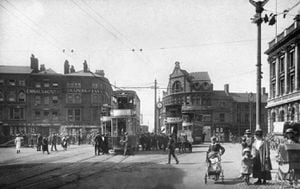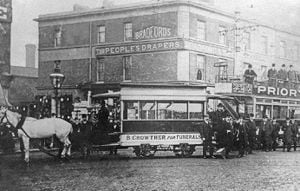Why Wolverhampton's tram system was a nasty shock for horses
Mind those trams – because for a relatively short while they were the height of fashion in Wolverhampton, the Black Country, and Birmingham.

They were connected by an extensive tram network, although operated by different companies.
And now the story of the region's trams has been told by Shrewsbury transport historian Peter Waller as part of his latest book in a series looking at Britain's tramways.
There can be few, if any, people alive today who can remember Wolverhampton's trams, but many will remember the trolley buses which spelt their doom.
"The Wolverhampton tramway was quite interesting," said Peter.
"Most tramways used overhead electric cables, a bit like modern electric railways, but Wolverhampton used a contact system where there was effectively a shoe underneath the tram which picked up the electric power.
"These systems were an alternative but they were never totally successful."

One problem was that the studs could become proud of the road surface.
"Horses would come along and electrocute themselves by touching the still-live stud contact. Wolverhampton was one of the few places in this country to have this system."
Peter says the tramways started in the late 19th century with horse trams and steam trams, and later electric trams.
Under the Tramways Act the councils would build the tramways, but lease them to companies to operate for 21 years. After that time the lease could either be renewed, or all the assets would pass to the council, which would then operate the system.
The upshot was that companies, knowing that councils might take over the operation, were reluctant to invest.
Another issue was that under the act the tram companies had to maintain the road surface for 18 inches either side of the tram track – making it the best section of road.
"The result was that, in an era before road maintenance, other road users would use the tram track and the trams would get blamed for traffic congestion."
After the Great War it was increasingly difficult to justify investment and the end was nigh for the Wolverhampton trams.

"Wolverhampton was a pioneer in early trolley buses. They could carry on using municipally powered electricity, but did not require track, using the ordinary road surface. They were cheaper to maintain and operate and gave greater flexibility as they could pull into the side of the road to pick up passengers when conventional trams couldn't.
"The Black Country, Wolverhampton and Walsall tramways really disappeared by the end of the 1920s. Dudley and Wednesbury were still served by Birmingham Corporation trams until 1939.
"Trams were a fashion, and at the end of the 19th century and start of the 20th it was a source of pride for municipalities for have a tramway system. By the 1920s and 1930s fashions had changed as buses were seen as more comfortable, had rubber tyres and were smoother on the road, and could carry more passengers. For a variety of reasons, traditional trams went out of favour."
In its heyday the Wolverhampton system had covered most of the town (as it was then).
"It was part of a massive network of 3ft 6ins gauge trams, stretching from Wolverhampton, through the Black Country, to Birmingham, and down to places as far as Rednal and Rubery. They were all interlinked, but owned and operated by different companies."
This meant anyone wanting to make a longer journey across the region by tram would need to change trams.
Peter's book, called "Regional Tramways – Midlands & Southern England" (Pen & Sword, £25), also looks at some modern tram systems, including the Midland Metro which links Wolverhampton and Birmingham.





